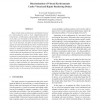Free Online Productivity Tools
i2Speak
i2Symbol
i2OCR
iTex2Img
iWeb2Print
iWeb2Shot
i2Type
iPdf2Split
iPdf2Merge
i2Bopomofo
i2Arabic
i2Style
i2Image
i2PDF
iLatex2Rtf
Sci2ools
102
click to vote
FBIT
2007
IEEE
2007
IEEE
Discrimination of Virtual Environments Under Visual and Haptic Rendering Delays
Many virtual reality systems have a distributed structure for certain purposes such as more computational power, tele-presence, collaboration, and portability. However, network delays are inevitable in the distributed structure and often make sensory information delivered behind time to the user. In the literature, the effect of network delays on the quality of virtual environments has been considered mostly with respect to task performances. In this paper, we pay attention to whether perceptual artifacts caused by network delays are perceptible by the user, which is a more stringent criterion than the degradation of task performance. We examined minimum perceptible visual and/or haptic rendering delays by measuring their discrimination thresholds between normal and delayed virtual environments with and without a task, and report the results in this paper. We also provide a simple guideline for determining whether some active delay compensation algorithms are required in a distributed...
| Added | 02 Jun 2010 |
| Updated | 02 Jun 2010 |
| Type | Conference |
| Year | 2007 |
| Where | FBIT |
| Authors | In Lee, Seungmoon Choi |
Comments (0)

